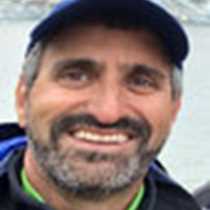Glacier Bay National Park and Preserve
“The glaciers need no narration”, spoke our visiting interpreter, Glacier Bay National Park Service Ranger Beth Brindle. Indeed these sinuous swaths of ice slicing through rugged mountain scenery speak for themselves. Their breathtaking beauty inspires a thousand stories. The crumbled white, powder blue and surreal azure hues of ice paint serene poetry. Contemplation of glaciers’ mysterious niveous nature, architectural prowess and imperceptible velocity fires a panorama of thought. But it is the tidewater glaciers, the icy streams of Alaska that snake down into seawater, that truly sound their own heralds, with reverberating resonance as towering frontline icy seracs crash into the glacial milk of the Inside Passage.
As ascribed by native Tlingit lore, calving glaciers explode with the voice of “white thunder”. As we learned today, it is ultimately not only the birth of icebergs that results from the action of the ice. Mountain mineral nutrients are excavated, transported and deposited into the marine ecosystem by these flowing frozen rivers, feeding summer food web productivity. Meltwater streams of friction-melted ice flow within glaciers, infusing freshwater into the ocean and possibly inciting localized upwelling. Recent research in well-studied Glacier Bay demonstrates high fish species diversity and abundance near the face of glaciers.
Calving of the glaciers supports Alaskan fauna in fascinating ways. The booming of collapsing icy palisades beckons neighboring seabirds. Sounding as a dinner bell, cascading glacial fragments stir the oceanic broth, kicking shrimp and other creatures to the surface. Kittiwakes, terns and gulls circle, hover and pluck meals from the icy waters, returning them to nearby nesting colonies. As chunks of ice are dispatched from the glaciers’ faces, they embark on floating journeys on meltwater and tidal currents, slowly melting as they go. These whitened rafts give shelter to mother harbor seals this time of year providing a relatively safe and remote nursery for their pups. Blood on the ice from births and nursing mother and pup seal pairs were observed on some of the icebergs we nosed through today.
Truly, the majestic curving carving currents of ice need no human narrative. Just as it has been Alaska State policy to not name any more features of this beautiful land’s geography, we let the glaciers speak for themselves. Aboard the Sea Bird we watched and listened intently as glaciers descended and icebergs were begotten, as these icy marvels of compacted snow heralded their role in shaping landforms and sustaining life about them.
“The glaciers need no narration”, spoke our visiting interpreter, Glacier Bay National Park Service Ranger Beth Brindle. Indeed these sinuous swaths of ice slicing through rugged mountain scenery speak for themselves. Their breathtaking beauty inspires a thousand stories. The crumbled white, powder blue and surreal azure hues of ice paint serene poetry. Contemplation of glaciers’ mysterious niveous nature, architectural prowess and imperceptible velocity fires a panorama of thought. But it is the tidewater glaciers, the icy streams of Alaska that snake down into seawater, that truly sound their own heralds, with reverberating resonance as towering frontline icy seracs crash into the glacial milk of the Inside Passage.
As ascribed by native Tlingit lore, calving glaciers explode with the voice of “white thunder”. As we learned today, it is ultimately not only the birth of icebergs that results from the action of the ice. Mountain mineral nutrients are excavated, transported and deposited into the marine ecosystem by these flowing frozen rivers, feeding summer food web productivity. Meltwater streams of friction-melted ice flow within glaciers, infusing freshwater into the ocean and possibly inciting localized upwelling. Recent research in well-studied Glacier Bay demonstrates high fish species diversity and abundance near the face of glaciers.
Calving of the glaciers supports Alaskan fauna in fascinating ways. The booming of collapsing icy palisades beckons neighboring seabirds. Sounding as a dinner bell, cascading glacial fragments stir the oceanic broth, kicking shrimp and other creatures to the surface. Kittiwakes, terns and gulls circle, hover and pluck meals from the icy waters, returning them to nearby nesting colonies. As chunks of ice are dispatched from the glaciers’ faces, they embark on floating journeys on meltwater and tidal currents, slowly melting as they go. These whitened rafts give shelter to mother harbor seals this time of year providing a relatively safe and remote nursery for their pups. Blood on the ice from births and nursing mother and pup seal pairs were observed on some of the icebergs we nosed through today.
Truly, the majestic curving carving currents of ice need no human narrative. Just as it has been Alaska State policy to not name any more features of this beautiful land’s geography, we let the glaciers speak for themselves. Aboard the Sea Bird we watched and listened intently as glaciers descended and icebergs were begotten, as these icy marvels of compacted snow heralded their role in shaping landforms and sustaining life about them.




